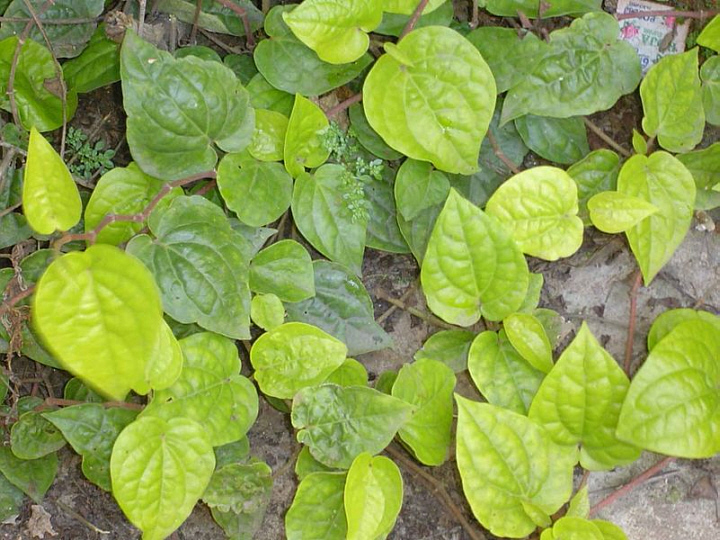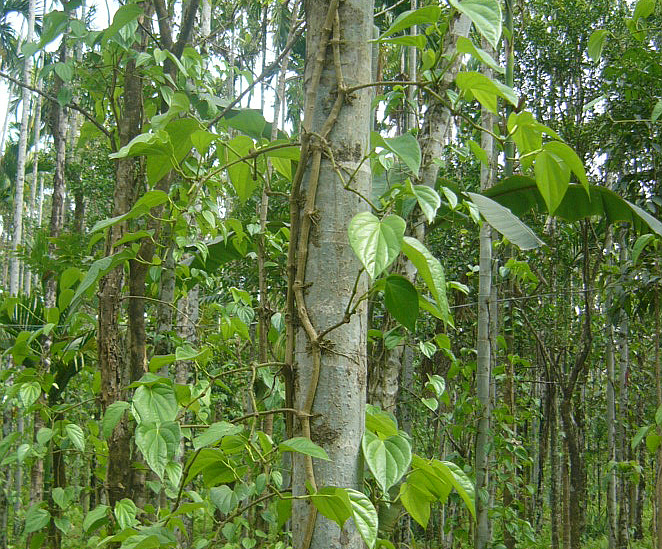

Zitierweise / cite as:
Carakasaṃhitā: Ausgewählte Texte aus der Carakasaṃhitā / übersetzt und erläutert von Alois Payer <1944 - >. -- Anhang A: Pflanzenbeschreibungen. -- Piper betle L. -- Fassung vom 2007-06-27. -- URL: http://www.payer.de/ayurveda/pflanzen/piper_betle.htm
Erstmals publiziert: 2007-06-27
Überarbeitungen:
Anlass: Lehrveranstaltung SS 2007
©opyright: Dieser Text steht der Allgemeinheit zur Verfügung. Eine Verwertung in Publikationen, die über übliche Zitate hinausgeht, bedarf der ausdrücklichen Genehmigung des Verfassers
Dieser Text ist Teil der Abteilung Sanskrit von Tüpfli's Global Village Library
WARNUNG: dies ist der Versuch einer
Übersetzung und Interpretation eines altindischen Textes. Es ist keine
medizinische Anleitung. Vor dem Gebrauch aller hier genannten Heilmittel wird
darum ausdrücklich gewarnt. Nur ein erfahrener, gut ausgebildeter ayurvedischer
Arzt kann Verschreibungen und Behandlungen machen!
Falls Sie die diakritischen Zeichen nicht dargestellt bekommen, installieren Sie eine Schrift mit Diakritika wie z.B. Tahoma.
Verwendete und zitierte Werke siehe: http://www.payer.de/ayurveda/caraka0001.htm
Piper betle L. = Chavica auriculata = Chavica betle Miq.= Chavica chuvya = Chavica densa = Chavica sibirica = Piper malamiris = Piper pinguispicus = Piper siriboa
lat. piper = Pfeffer; malayalam veṭṭila = Kaupfeffer
Piperaceae - Pfeffergewächs
"The plant is evergreen and perennial, with glossy heart-shaped leaves and white catkins, and grows to a height of about 1 metre." (Wikipedia)
sanskrit:
tāmbūla: Caraka I,5.77 (āsyena dhāryāṇi)
Bhāvaprakāśa:
tāmbūlavallī
tāmbulī
nāginī
nāgavallarī
dt. Betelpfeffer, Kaupfeffer
engl. Betel, Betel Pepper
Bestandteile des Öls aus den Blättern: u. a. Cadinen, α-Chavicol, Chavibetol, Anethol, Cineol, Eugenol, γ-Caryophyllen
Bhāvaprakāśa: I, S. 229
Pandey: III, 600ff.
Hunnius: s.v.
Wikipedia: http://en.wikipedia.org/wiki/Piper_betle. -- Zugriff am 2007-05-17

Abb.: Piper
betle L.
[Bildquelle: Wikipedia]

Abb.: Piper
betle L. als Baumkletterer, Jaflong, Sylhet (সিলেট) , Bangladesh (বাংলাদেশ)
[Bildquelle: Wikipedia]
Drury:
"Chavica betle (Miq.) N. O. PIPERACEAE. Betleleaf Pepper, Eng. Vetta, Mal. Vettilee, Tam. Pan, Beng. Tamala-pakoo, Tel.
Description.—Shrubby, scandent, rooting, branches striated; leaves membranaceous, or the adult ones coriaceous, shining above, glabrous on both sides; the inferior ones ovate, broadly cordate, equal-sided; slightly-unequally cordate, or rounded at the base, 5-6-nerved; catkins peduncled; male ones long, slender, patulous or deflexed; female deflexed, shorter, long-peduncled.— Wight Icon. t. 1926.—Piper betle, Linn.—Roxb. Fl. Ind. i. 158.—Rheede, vii. t. 15.-------Cultivated.
Medical Uses.--The leaves in conjunction with lime are masticated by all classes of natives, and for this purpose the plant is extensively cultivated. The juice of the leaves is regarded as a valuable stomachic. In catarrhal and pulmonary affection, especially of children, the leaves wanned and smeared with oil are applied in layers over the che3t. They thus afford great relief to coughs and difficulty of breathing. A similar application has afforded marked relief in congestion and other affections of the liver. The leaves simply warmed and applied in layers to the breasts will arrest the secretion of milk. They are similarly employed as a resolvent to glandular swellings.—(Pharm. of India.) Dr Elliott of Colombo has observed several cases of cancer, which, from its peculiar characteristics, he has designated the Betle-chewer's cancer.
Economic Uses.—The leaf is chewed by the natives mixed with chunam and the nut of the Areca palm. It has been found wild in the island of Java, which is probably its native country. Marco Polo writes: "The natives of India in general are addicted to the custom of having continually in their mouths the leaf called ' tem-bul;' which they do partly from habit, and partly from the gratification it affords. Upon chewing it they spit out the saliva which it occasions. Persons of rank have the loaf prepared with camphor and other aromatic drugs, and also with a mixture of quicklime. I have been told that it is conducive to health. It is capable, however, of producing intoxicating effects, like some other species of Popper, and should be used in moderation." In Travancore it is extensively cultivated, but only sufficient for home consumption. It is planted in rows, requires a moist situation and a rather rich soil. The leaves should not be plucked indiscriminately at all seasons, as this is apt to destroy the plant. —Lindley. Ainslie."
[Quelle: Drury, Heber <1819 - 1872>: The useful plants of India : with notices of their chief value in commerce, medicine, and the arts. -- 2d ed. with additions and corrections. London : Allen, 1873. -- xvi, 512 p. ; 22 cm. -- s.v.]
Dutt:
"PIPER BETLE, Linn. Sans. Tāmbula. Vern. Pān, Beng. Hind.
The leaves of this creeper are, as is well known, masticated by the natives of India. The Poorer classes make their packet of betle with the addition of lime, catechu and betle nuts. The rich add cardamoms, nutmegs, cloves, camphor and other aromatics. Betle-leaf thus chewed acts as a gentle stimulant and exhilarant. Those accustomed to its use feel a sense of langour when deprived of it. The ancient Hindu writers recommend that betle-leaf should be taken early in the morning, after meals and at bed-time.
According to Susruta, it is aromatic, carminative, stimulant and astringent. It sweetens the breath, improves the voice and removes all foulness from the mouth. According to other writers it acts as an aphrodisiac.
Medicinally it is said to be useful in diseases supposed to be caused by deranged phlegm and its juice is much used as an adjunct to pills administered in these diseases ; that is, the pills are rubbed into an emulsion with the juice of the betle-leaf and licked up. Being always at hand, pan leaves are used as a domestic remedy in various ways. The stalk of the leaf smeared with oil is introduced into the rectum in the constipation and tympanitis of children, with the object of inducing the bowels to act. The leaves are applied to the temples in headache for relieving pain, to painful and swollen glands for promoting absorption, and to the mammary glands with the object of checking the secretion of milk. Pān leaves are used as a ready dressing for foul ulcers which seem to improve under them."
[Quelle: Dutt, Uday Chand: The materia medica of the Hindus / Uday Chand Dutt. With a glossary of Indian plants by George King. -- 2. ed. with additions and alterations / by Binod Lall Sen & Ashutosh Sen. -- Calcutta, 1900. - XVIII, 356 S. -- S. 244f..]